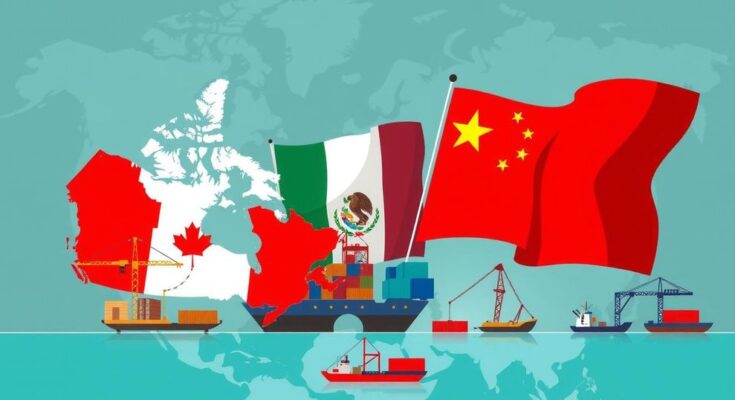President Trump’s recent tariffs on imports from Canada, Mexico, and China have sparked a trade war, risking the U.S. economy due to unclear motivations. Canadian Prime Minister Trudeau criticized Trump’s rationale, leading to retaliatory tariffs. The U.S. stock market has declined sharply, and economists predict significant economic impacts, including increased consumer costs and slowed growth. Political reactions reveal divisions among congressional leaders about the tariffs’ necessity and implications.
President Trump’s recent imposition of tariffs on imports from Canada, Mexico, and China represents a significant risk, leading to a trade war that could jeopardize the U.S. economy. These measures have confused and angered America’s major trading partners, prompting fears of economic instability. The motivations behind the tariffs are unclear, ranging from accusations against other nations for not curbing drug trafficking to claims of protecting American jobs and manufacturing.
In response, Canadian Prime Minister Justin Trudeau expressed confusion over Trump’s rationale, suggesting that the tariffs aim to damage Canada’s economy significantly. Trudeau emphasized that Canada would not become a mere extension of the United States, asserting, “That’s never going to happen. We will never be the 51st state.” In retaliation, Canada proposed tariffs on $30 billion worth of American imports, understanding that both economies would suffer from such measures.
The repercussions have already manifested, with U.S. stock markets experiencing significant declines, particularly affecting the financial sector. As the S&P 500 dropped sharply, analysts warned that the economic outcomes of these trade policies could worsen with increased costs for consumers and persisted inflation, undermining President Trump’s goals of economic growth.
Various business groups have reacted with urgency, contemplating legal recourse against the tariffs that impose a 25% tax on products from Canada and Mexico while raising previous tariffs on China by 10%. Retailers have cautioned that these tariffs could hinder recovery from challenging economic conditions, positing that they may lead to price increases soon, complicating consumer spending.
Moreover, economists project that sustained tariffs could decelerate economic growth by approximately one percentage point, and households might face an annual increase in everyday expenses by about $1,000 due to the tariffs. While certain unions praised the tariffs for promoting domestic manufacturing, the anticipated economic fallout appears to outweigh potential benefits, prompting many businesses to reconsider their strategies.
Trump’s stance remained unwavering, encouraging companies to relocate factories to the U.S. to avoid tariffs. His administration justified these tariffs as necessary measures against countries unable to manage drug flows, despite statistics showing recent improvements in overdose death rates.
International responses have included efforts by Mexico and Canada to diversify trade partnerships beyond the U.S., as both countries seek to mitigate the impacts of these tariffs. The implications of the tariffs reveal stark differences in economic dependence, highlighting the potential adverse effects on Canada and Mexico, whose economies rely heavily on trade with the United States.
Following the tariffs’ announcement, opinions from congressional leaders reflected a divide, with some Republicans endorsing the measures as temporary while Democrats vocally opposed them. The situation illustrates the complexities of U.S. trade policy and its potential to disrupt international relations while impacting domestic economic stability.
President Trump’s imposition of tariffs on imports from Canada, Mexico, and China poses substantial risks to the U.S. economy and its international relations. The unclear rationale for these tariffs has led to retaliatory measures, contributing to market declines and heightened consumer costs. As various sectors begin to feel the impact, the economic outlook remains uncertain, highlighting the challenges posed by such aggressive trade policies and reinforcing the need for careful negotiations.
Original Source: www.nytimes.com




